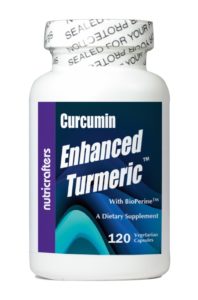Over the years, we’ve seen the golden color of turmeric in some of our favorite curry dishes and have indulged ourselves in its delightful flavor. But as delicious as it is, it offers more than just its color or flavor. It has a long historical use in Ayurvedic medicine and has been used to treat gastrointestinal disorders, arthritic pain, low energy and other disorders with great results.
Back in 1910, two researches, Lampe and Milobedzka, were curious to know what made turmeric tick. With some exploration, they discovered curcumin, which makes up about 3 – 5% of the spice and gives it a golden color.
Early research shows that curcumin acts in several ways but one of its most prominent activities is its anti-inflammatory action. Researchers report that curcumin is pleiotropic meaning that it has several effects. What are some of these effects?

Curcumin suppresses a compound called nuclear factor-kappa B. Nuclear factor-kappa B is involved in regulating the enzymes – inducible nitric oxide synthase (iNOS) and cyclooxygenase-2 (COX-2). By curcumin’s action of suppressing Nuclear factor-kappa B., it also inhibits the inflammatory action of COX-2 and iNOS.
Curcumin stops the production the inflammatory cytokines – tumor necrosis factor-alpha (TNF-alpha), interleukins (IL) -1, -2, -6, -8, and -12, and others. In-vitro studies have shown that curcumin blocks the expression of the cytokine genes by regulating transcription factors or regulating the transfer of genetic information of these compounds.
In an animal model, curcumin was shown to stop the action of arachidonic acid and inflammation in the skin of mice by down-regulating cyclooxygenase and lipoxygenase pathways. These early findings show curcumin to be a potent anti-inflammatory supplement but is this seen in human studies?
Forty-five patients experienced spermatic cord edema after inguinal hernia or hydrocele surgery. Researchers gave the patients either 400 mg curcumin, 100 mg phenylbutazone, or a placebo three times daily for six days. Researchers noted that both curcumin and phenylbutazone reduced inflammation at similar levels but only curcumin reduced the inflammation at the surgical site. This study reveals that curcumin is an effective treatment for post-surgery inflammation.1
In a double-blind, randomized-controlled trial, researchers examined curcumin’s influence on rheumatoid arthritis. Rheumatoid arthritic patients were given 1,200 mg curcumin and this was compared to those who received phenylbutazone. Although phenylbutazone showed a greater benefit, curcumin improved joint swelling, morning stiffness and walking time.
Other studies have shown the benefits of curcumin in gastrointestinal conditions, pancreatitis, cancer involving inflammation, cognitive function, blot clotting prevention, heartburn, liver protection, and other areas.2
These studies are preliminary; however, they show promising results.. Because of the strong evidence, researchers have started conducting ongoing clinical trials that further examine curcumin’s potential to reduce swelling. One pilot trial will examine curcumin’s influence on rheumatoid arthritis and is being conducted at University of California, Los Angeles. The other trial is in its third phase and is examining curcumin’s influence on knee osteoarthritis.
Curcumin From Turmeric Can Treat and Protect Against Alzheimer’s Disease
Eating curry dishes helps increase curcumin in your diet, but taking a curcumin supplement can help you reach beneficial levels. Who would have thought a dusting of this golden spice could offer so much promise to relieve pain and swelling?
References
- Turmeric (Curcuma longa Linn.) and curcumin. http://www.nlm.nih.gov/medlineplus/druginfo/natural/patient-turmeric.html. Accessed January 31, 2009.
- Jurenka JS. Anti-inflammatory properties of curcumin, a major constituent of Curcuma longa: A review of preclinical and clinical research. Alternative Medicine Review. 2009;14(2):141-153.
